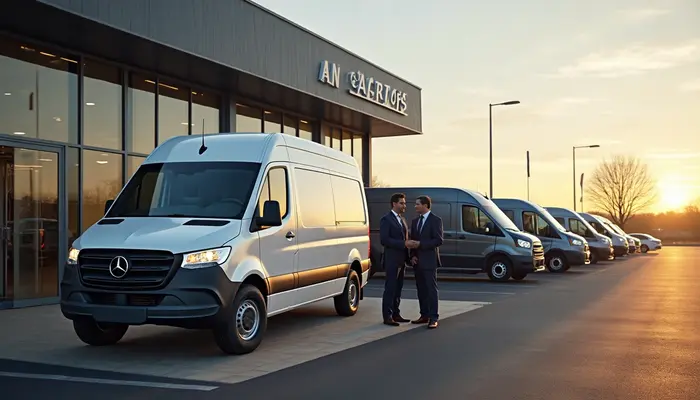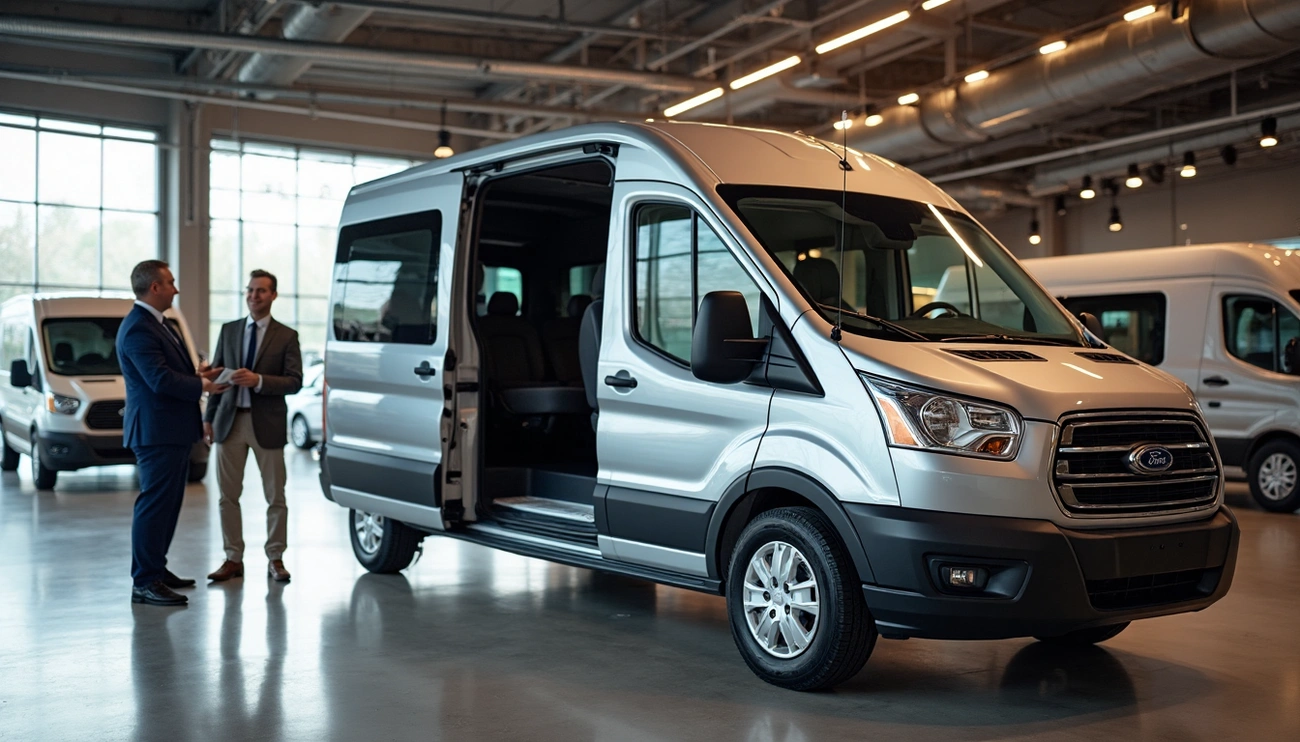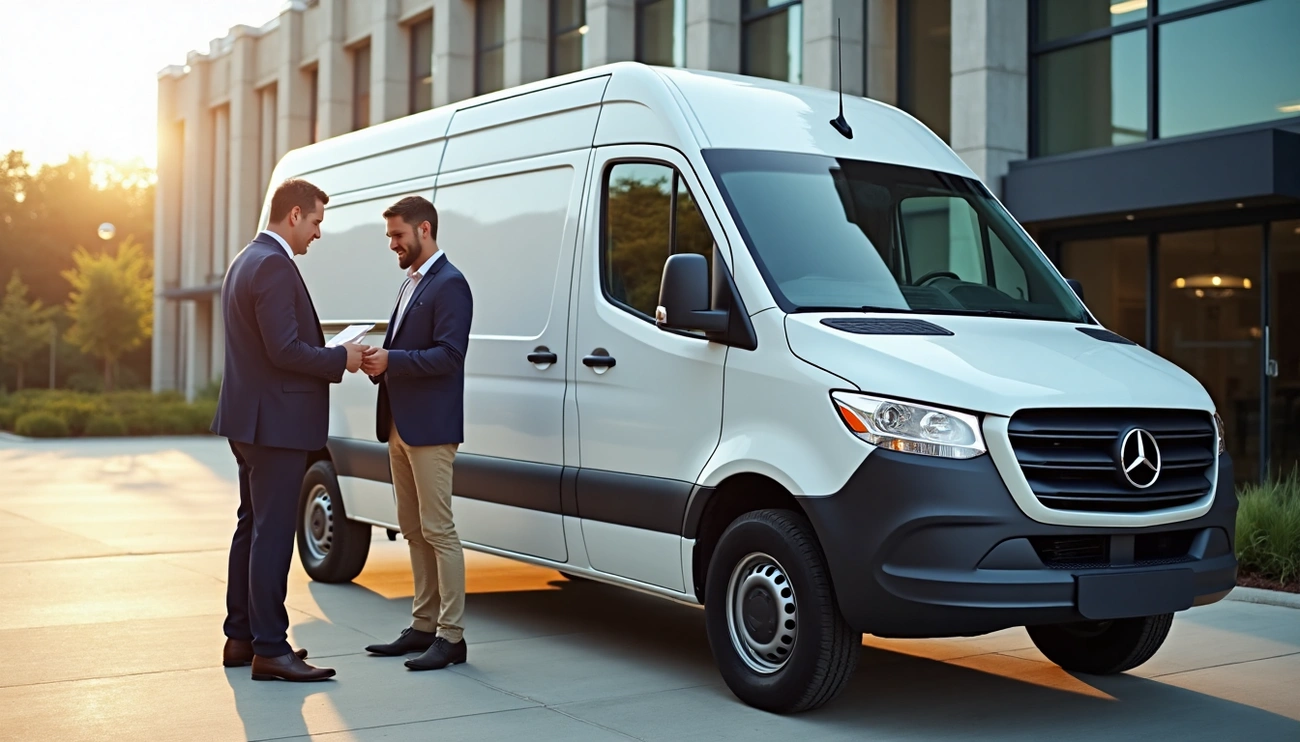Van Leasing: Everything You Need
Business van leases start at just £100 monthly. This makes them a budget-friendly choice for companies that need vehicles without paying large sums upfront. Leasing gives you access to new vans with predictable monthly payments instead of investing capital in an asset that loses value. Source Van Leasing deals
Your business can claim back 100% of the VAT on leased vans used only for business. This tax benefit is a big deal as it means that depreciation costs more than fuel, servicing, and insurance put together.
This piece covers everything about van lease deals. You’ll learn how leasing works and see how costs compare between different providers. We’ll help you find the right van lease that fits your needs, whether you want short-term flexibility or long-term reliability.

What is Van Leasing and How Does it Work?
Thinking about getting a new van but don’t want to pay a huge amount upfront? Van leasing could be your answer. Let me explain everything about this popular option that works great for both businesses and individuals. See Ice Cream Van Tracker
Definition and key terms
Van leasing works as a long-term rental where you pay monthly to drive a van for a set time, usually 2-5 years. You don’t own the vehicle – you just pay to use it during the agreement.
You start with an original rental payment that works like a deposit but costs much less than buying. After that, you make fixed monthly payments until the lease ends. The van goes back to the leasing company once your contract finishes. See Hire an Ice Cream Van
These important terms show up often in leasing agreements:
- Business Contract Hire (BCH) – The most common type of van leasing for businesses where you return the vehicle at the end
- Finance Lease – Lets businesses use the van without owning it but has a final “balloon” payment
- Personal Contract Hire (PCH) – Like BCH but has VAT in the payments
- Contract Purchase – Lets you buy the van after the lease ends. Source
How van lease hire is different from buying
The main difference between leasing and buying comes down to ownership. Leasing means you rent the van long-term, while buying means you’ll own it someday. See start and Ice Cream Van Business
Buying a van means paying the full price upfront or getting a loan to own it later. Leasing needs no big money upfront – just an original rental and monthly payments you can manage.

Here’s how leasing compares to buying:
- Upfront costs: Leasing needs much less money to start
- Monthly payments: You’ll pay less monthly with a lease than a loan
- Ownership: Leasing means you never own the van – it goes back at the end
- Depreciation: Leasing helps you avoid losing money on depreciation – the finance company handles that
- Tax treatment: VAT-registered businesses can usually claim VAT back on lease payments and use them as business expenses
Short term vs long term van lease
You can choose between short-term and long-term agreements. Each option has its benefits based on what you need.
Short-term van leases run from one month to 24 months. These work well for businesses that need flexibility or have temporary projects. This option makes sense if you’re not sure about your long-term vehicle needs or have a project with a clear end date. See Ice Cream Vans for sale
Long-term leases usually last 24 to 60 months and work best for businesses that want stability and lower costs. Spreading payments over more time reduces your monthly costs – our research shows 36-month deals can start at £329 monthly compared to £349 for 12-month deals.
The main difference? Short-term leases give you more flexibility but cost more monthly. Long-term agreements cost less per month and offer stability but don’t adapt easily as your business grows.
Your choice depends on your business needs, budget and how well you can predict your future requirements.
Types of Vans You Can Lease
Businesses just need to understand the various van types available for lease to pick the right vehicle. The market has options ranging from compact city runners to spacious logistics vehicles that match specific business requirements.
Small vans for city driving
City vans provide an excellent balance between car-like handling and practical storage capabilities. These compact vehicles excel in urban environments where maneuverability matters most. Their typical load dimensions are 1.7 meters (length), 1.5 meters (width), and 1.2 meters (height).
The Ford Transit Connect, Peugeot Partner, Renault Kangoo, Citroen Berlingo, and Ford Fiesta Van are popular models for small van lease. These vehicles can carry impressive payloads from 600kg to nearly 1,000kg. DJs, florists, photographers, couriers, and electricians find these vans perfect for their business.
The small van category welcomes electric technology too. The Mercedes-Benz eVito leads the pack with ranges over 100 miles between charges.
Medium vans for tradespeople
Medium-sized vans hit the sweet spot between compact city vehicles and large cargo carriers. These versatile vehicles have average load dimensions of 2.4 meters (length), 1.7 meters (width), and 1.4-1.65 meters (height). Tradespeople love them.
Side doors and rear-loading capabilities make medium panel vans a great choice. Joiners, plumbers, builders, and other manual workers who move larger items find them especially useful. The Citroen Dispatch, Vauxhall Vivaro, Ford Transit Custom, and electric Nissan eNV200 are popular lease options.
Electricians, plumbers, and builders can access reliable transportation without large upfront costs through medium van leasing.

Large vans for logistics
Maximum cargo space and load capacity make large vans the top choice for many businesses. These spacious vehicles come with powerful engines designed for demanding workloads.
The Peugeot Boxer, Mercedes Sprinter, Volkswagen Crafter, Ford Transit, and Renault Master lead this segment. Large vans offer multiple lengths, wheelbases, and heights. This makes them perfect for logistics, construction, and heavy goods transportation.
These vehicles’ reliable design and substantial payload capacity make them vital to many delivery and logistics operations.
Electric vans and hybrid options
Electric and hybrid van leasing has gained momentum as businesses look for eco-friendly alternatives. Lower running costs, reduced emissions, quieter operation, and tax incentives make these vehicles attractive.
Modern electric vans impress with their range—typically 100-200 miles on a single charge. The Fiat E-Ducato stands out with up to 224 miles. The Renault Kangoo ZE, Nissan e-NV200, Mercedes-Benz eVito, and Volkswagen e-Transporter are popular electric options.
The Ford Transit Custom Plug-in Hybrid and Mitsubishi Outlander Commercial PHEV offer middle ground options for those not ready to go fully electric.
Crew vans and pickups Van Leasing
Crew vans excel at moving both people and cargo. These vehicles can carry up to six passengers while keeping substantial cargo space. Their average load dimensions are 1.5 meters (length), 1.4 meters (width), and 1.2 meters (height).
The rear seats in many crew vans can be removed to use the full loadspace when needed. The Volkswagen Transporter Combi, Renault Trafic Crew, Vauxhall Vivaro Double Cab, and Ford E-Transit Double Cab are popular lease options.
These vehicles have side windows but remain classified as commercial vehicles for tax purposes. This makes them an excellent choice for businesses that need dual functionality.
Benefits of Leasing a Van
Leasing a van gives your business many advantages that go well beyond just having a vehicle ready to use. The benefits range from money management flexibility to easier operations. These insights will help you make better decisions about managing your fleet.
Lower upfront costs
Businesses choose van leasing because it needs much less money to start. You don’t have to spend big money like when buying – just a small payment upfront and then manageable monthly payments. Your business can keep its money free to spend on other important projects or investments.
This makes perfect sense for startups and small businesses that don’t have lots of cash. You can drive newer, better vehicles that you might not be able to buy outright.
Fixed monthly payments
The best part about van leasing is how it makes your finances predictable. Once you sign the lease contract, your monthly fee stays the same until the agreement ends. Your business can plan its cash flow better and budget more accurately.
Your monthly costs become crystal clear and you won’t face any budget surprises. The fixed cost takes care of road tax and usually includes breakdown recovery. Everything rolls into one easy payment.
No depreciation worries Van Leasing
Owning a van comes with a big challenge – depreciation. Vehicles can lose 50-60% of their value in just three years. Commercial vans lose value even faster than regular cars.
The leasing company takes on all this risk when you lease. You just use the van and give it back when you’re done. This means you don’t have to worry about selling it later or getting stuck with an old vehicle.
Tax advantages for business van lease
VAT-registered businesses get some great tax benefits from van leasing. Your options depend on the type of agreement:
- Contract Hire leases let you claim all rental payments as tax-deductible expenses, and you might get VAT back
- Finance Leases allow you to offset interest charges against yearly profits
- Contract Purchase deals help VAT-registered companies avoid VAT on monthly finance payments
The amount of VAT you can get back matches your business usage. To name just one example, using the van 80% for business means you can claim 80% of the VAT.
Maintenance and insurance options
Optional maintenance packages add extra peace of mind. They cover servicing, MOTs, and repairs throughout your lease. Your van stays in great shape without surprise repair bills.
Many companies now offer “Complete Care” packages. These bundle your leased van with insurance, maintenance, breakdown cover, and accident management into one monthly payment. You get coverage for repairs from accidents, fire, or theft during your lease. They also provide breakdown help and replacement vehicles when yours needs fixing.
Understanding Van Lease Costs and Deals
Businesses need to understand what drives van lease prices before they sign a contract. Only when we are willing to look at these factors can you get the best deal that fits your needs.
What affects van lease prices?
Your chosen van’s make, model, and specifications will affect your lease costs. You’ll pay more for premium brands because their original purchase prices are higher. Bigger vans cost more to lease than smaller ones due to their size, weight, and capacity.
There’s another reason – the lease duration. Longer terms mean lower monthly payments since costs spread across more months. But this means you end up paying more over the entire contract.
The amount you pay upfront changes your monthly costs. A bigger first payment brings down your monthly amounts, though the total lease cost stays about the same. Your mileage limits also shape the price – lower limits help protect the van’s value, but going over costs you 6p-12p for each extra mile.
Comparing van lease deals
Comparison websites help you gather multiple offers quickly. You can filter these sites by the van make, model, and how long you want to lease.
Look beyond the monthly payment to check residual value estimates. If a lessor’s estimate is more than 10% below market averages, you have room to negotiate. Make sure to check what maintenance packages include and don’t include – all but one of these packages cover tire replacements, brake system parts, and cosmetic repairs.
Van lease special offers and stock deals
Leasing companies often have special deals on vans they have in stock, with delivery in 2-4 weeks. These “Fast Lease” deals give you quick access to vans at special prices.
Paying more at the start brings your monthly costs down to more manageable levels. Stock deals usually come with road tax and breakdown coverage, and you can add maintenance packages starting at £22 per month.
Van lease and insurance packages
“Complete Care” packages combine your leased van with full insurance, maintenance, breakdown coverage, and accident management into one monthly payment. These packages cover repair costs from accidents, fire, or theft throughout your lease.
You get peace of mind with breakdown help that includes replacement vans during repairs. Standard lease deals don’t include insurance, but you must have it – either through the leasing company or on your own.
How to Lease a Van: Step-by-Step
Want to lease a van? Here’s how you can break down the leasing process into four simple steps that will get you driving your new business vehicle.
Choose your van and contract terms
You need to pick a van that matches your business needs. Take a look at the available models and think over factors like size, payload capacity, and fuel efficiency. Your lease duration comes next – you can choose between 2 to 5 years, and most businesses go for 2, 3, or 5-year terms. The payment structure, including your first payment and monthly costs, depends on your chosen lease package.
Customize mileage and extras
Your annual mileage limit needs to be set before finalizing the agreement. You can pick from common options like 5,000, 8,000, 10,000, or 12,000 miles per year. Keep in mind that going over your agreed limit leads to excess mileage charges from 3p to 30p per mile. You can add valuable extras at this point, such as maintenance packages that cover services, MOTs, and replacement tires.
Submit documents and credit check
The next step after setting up your ideal van lease package involves providing financial details for credit approval. Business leases require:
- Company details and director information
- Business bank account details
- Sometimes additional documents like bank statements or management accounts
A standard credit check helps ensure you can handle the monthly payments comfortably. Credit approval lets you specify your first payment amount and secure your new van with a holding deposit.
Van delivery and handover process
Your new van arrives at your chosen location after all paperwork is complete. The handover requires you to check the vehicle and document any damage or issues on the delivery paperwork – this is vital since you might become responsible for unmarked damage later. The delivery driver explains the van’s key functions and answers your questions before you sign the final delivery documents.
Conclusion Van Leasing
Final Thoughts on Van Leasing
In this piece, we’ve looked at why van leasing works better than buying outright for businesses of any size. The financial benefits make a strong case. You need minimal upfront investment, your monthly payments stay predictable, and you don’t have to worry about depreciation. These factors make leasing an attractive option.
The wide range of vehicles will give a perfect match for what you need. You might want a quick city van to zip around town, a strong medium van for trade work, or a big cargo carrier for logistics. Leasing lets you access these vehicles without spending huge amounts of capital.
Tax benefits make van leasing even more appealing. VAT-registered businesses can claim back much of their payments. This turns what looks like an expense into a smart financial move. Maintenance packages help you avoid surprise repair costs and keep your business moving smoothly.
Our four-step leasing process shows how easy it is to get your new van. Pick your vehicle, set your terms, sign the papers, and drive away – without ownership hassles.
So before you decide how to get your next van, think over if leasing could work better for your business goals. The mix of financial flexibility, tax advantages, and simple operations has made van leasing a top choice for smart businesses. Your business deserves reliable transport that saves money while giving you the tools to grow.
FAQs
Q1. What are the main advantages of leasing a van over buying one? Leasing a van offers lower upfront costs, fixed monthly payments, and no depreciation worries. It also provides tax advantages for businesses and often includes maintenance options, making it a cost-effective and flexible solution for many companies.
Q2. How long are typical van lease agreements? Van lease agreements typically range from 2 to 5 years. Most businesses opt for 2, 3, or 5-year terms, depending on their specific needs and financial situation. Longer terms generally result in lower monthly payments but may lead to higher overall costs throughout the contract.
Q3. Can I lease an electric or hybrid van? Yes, electric and hybrid vans are available for lease. These eco-friendly options offer lower running costs, reduced emissions, and potential tax incentives. Popular electric van models include the Renault Kangoo ZE, Nissan e-NV200, and Mercedes-Benz eVito, with ranges typically between 100-200 miles on a single charge.
Q4. What factors affect the cost of leasing a van? The cost of leasing a van is influenced by several factors, including the make and model of the van, lease duration, initial payment amount, annual mileage allowance, and any additional features or maintenance packages included in the agreement.
Q5. Do I need to arrange insurance separately when leasing a van? While insurance isn’t automatically included in standard lease deals, it’s a mandatory requirement. You can either arrange insurance independently or opt for a “Complete Care” package that bundles the lease with comprehensive insurance, maintenance, and breakdown coverage into one monthly payment.



